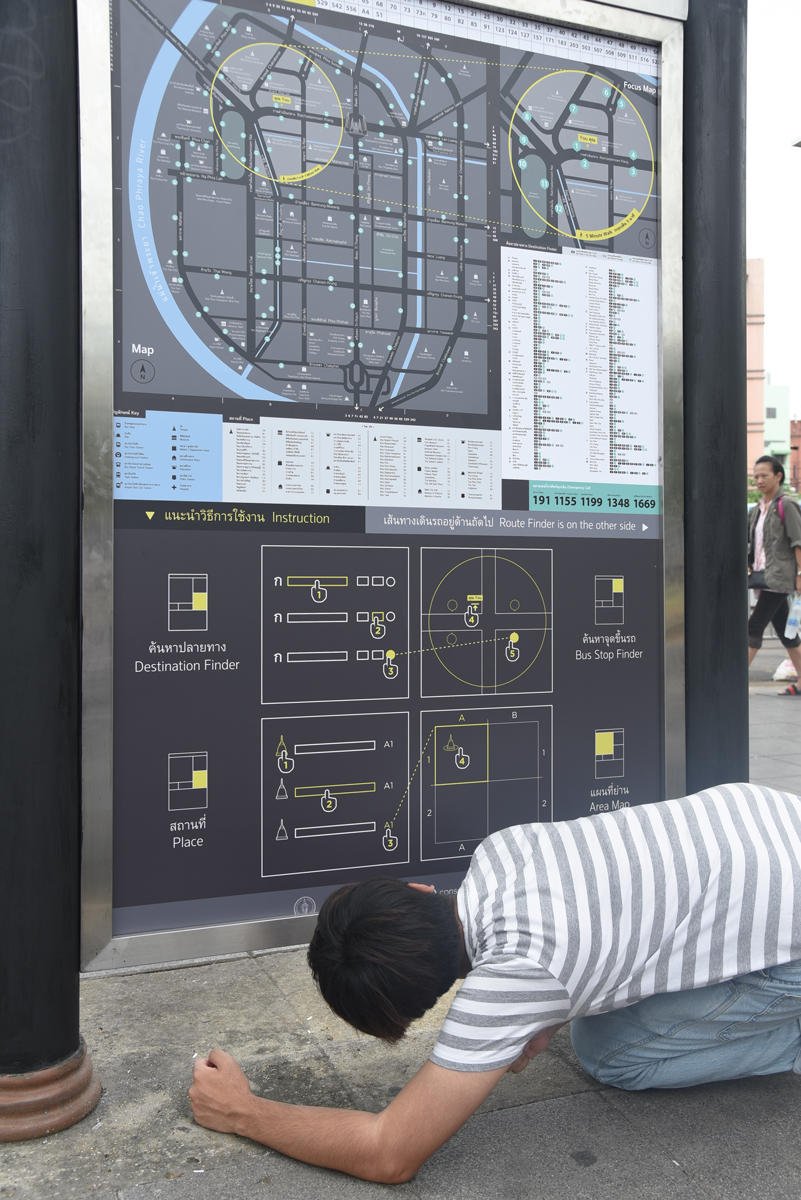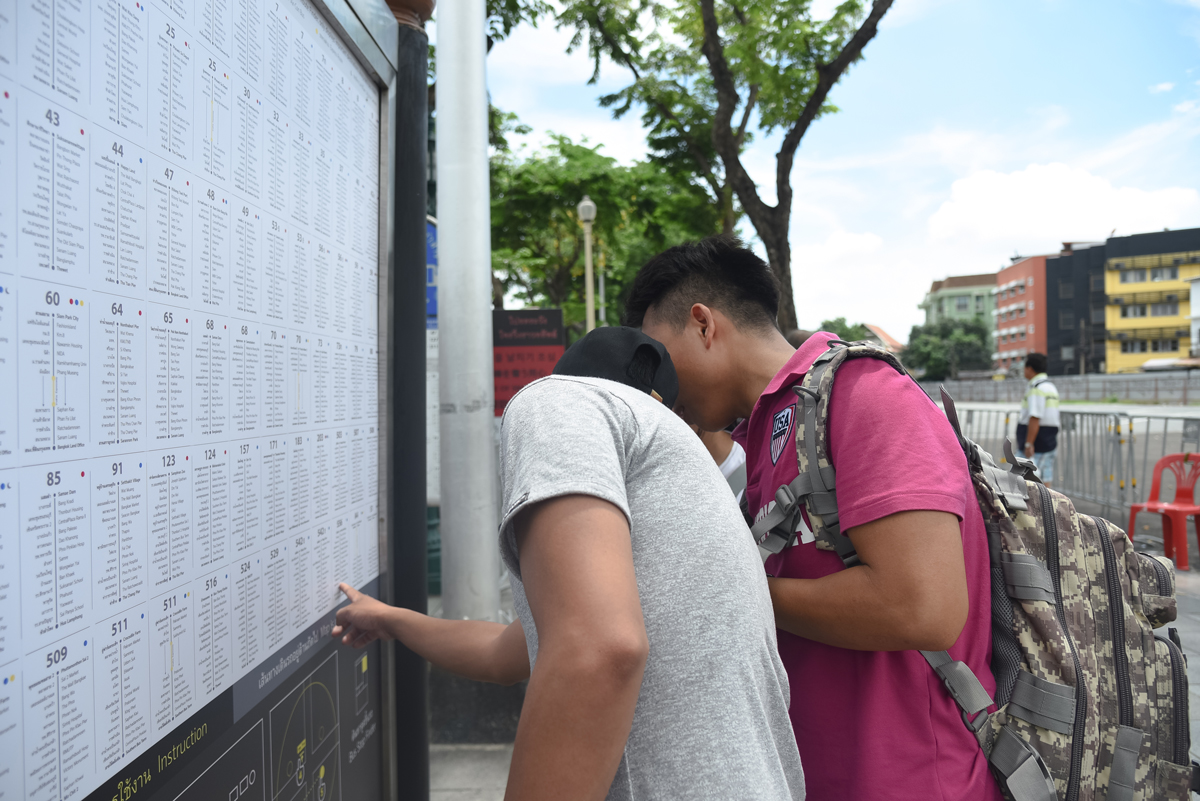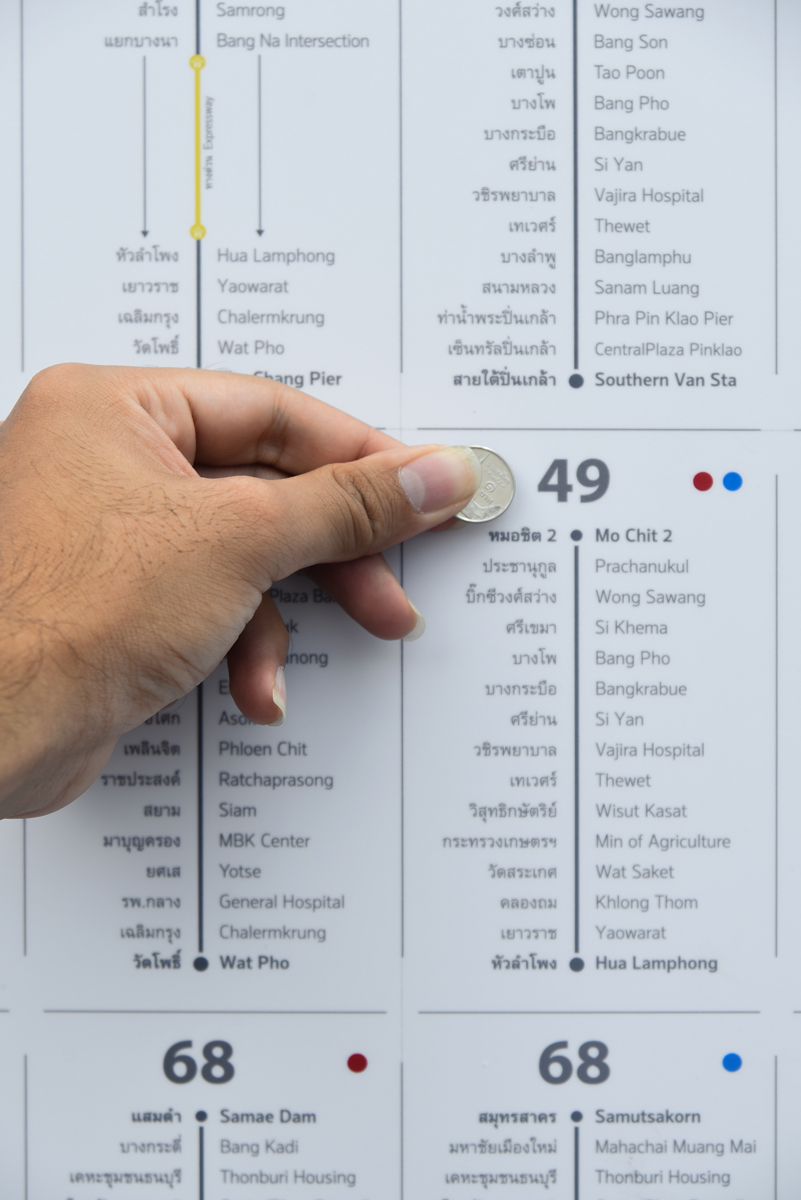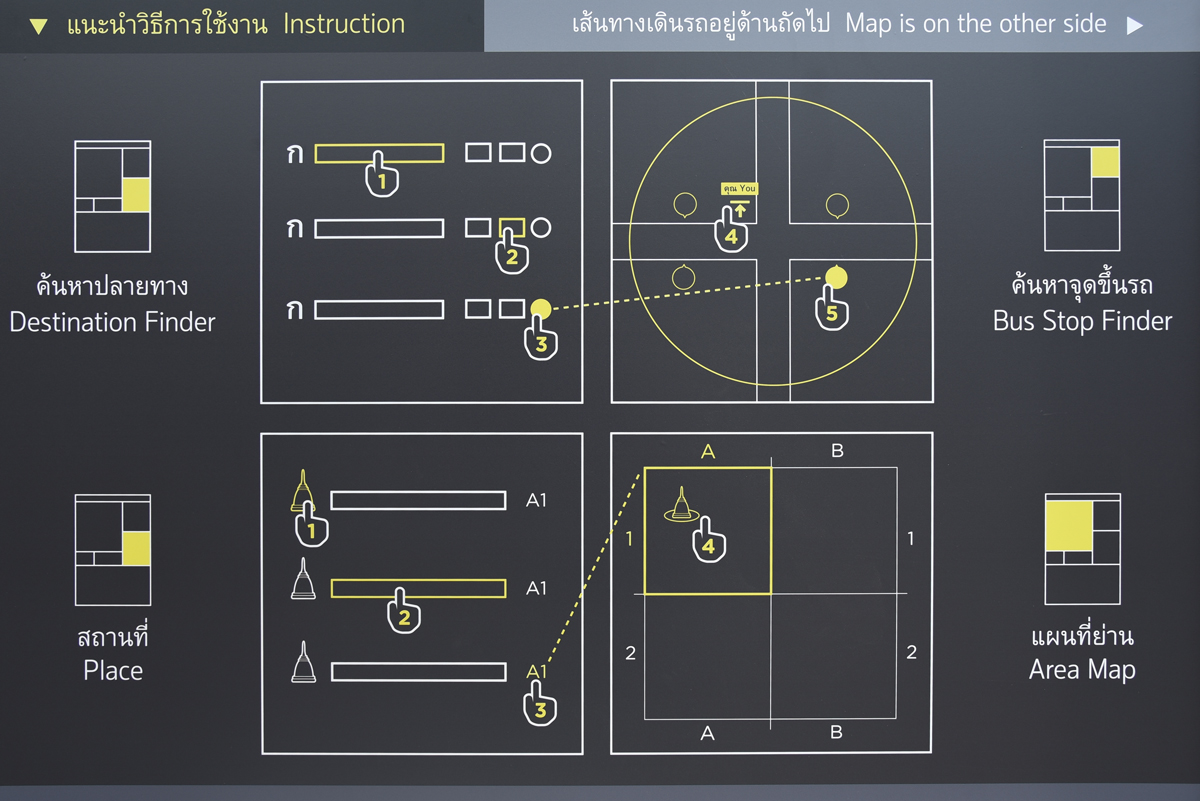A TRIAL VERSION OF A BUS STOP REDESIGNED BY MAYDAY! INTRODUCES US TO A NEW WAY OF NAVIGATION
After art4d published the article around the end of last year about the bus station sign by MAYDAY! that would be used around the Rattanakosin Island, the question we left off with of how this movement could make the government sector realize the importance of the participation of the people has now been answered as MAYDAY! has been called back to work on another project with the Bangkok Metropolitan Administration. It’s undeniable that what has allowed for the collaboration between MAYDAY! and the governmental agency to ‘co-create’ the project with the public is the drama over the image of a person bending down to read the tiny information on the bus stop sign that went viral on the Internet.

“To the question of whether this is the sequel of the last bus stop sign project, well, yes. But we feel like what we have done hasn’t really solved more than 5% of the problems regarding public transportation in Bangkok, so more sequels can definitely be expected,” Waritthorn Suksabai, one of the members of MAYDAY! told art4d. The prototypes are now being installed at the bus stops in front of the old Government Lottery Office building and Chatuchak Weekend Market. The two areas were chosen for the large number of users with a great diversity of nationalities and age groups ranging from Thai daily commuters to foreigners. “The prototypes are only an implication that we haven’t really come to any conclusion for which the design is the final answer. We want to hear feedback from the actual users and their opinions on the readjusted colors and layout.”
To provide greater understanding, there are three types of bus stop signs. Type A is a bus stop sign, Type B is a resting pavilion and Type C is an index sign, which features all the bus stops in the neighborhood, meaning that Type C provides more comprehensive information than Type A (indicating destinations commuters can travel to from a particular bus stop they are at). Wee Viraporn, a graphic designer for conscious and senior consultant of ThaiGa (Thai Graphic Designers Association), talked to us about the design process of the project and how the limited deadline was one of the reasons why the design wasn’t really originated from research and data collection like it should have been. “We started off by using the original design as the hypothesis. We do understand the intention and good will of the first design that tried to include all the information.” One of the major problems of the prototype was the size of the font that was too small to read. What they decided to do with the new version was to eliminate the 80-centimeter space at the bottom part of the sign since it was much too far below the average eye level of users.

“We tried to find the regulations in data selection and discovered that a sign doesn’t need to actually contain all the information about all the bus stops. So from that point, we tried to create a new data selection system while at the same time trying to avoid the overlap of information with the Type A sign as much as we could.” Suksabai further explained that the team put the readability of the font as a first priority in order to speculate the space on the sign (the dimension of a Type A sign is 120 x 180 centimeters) that they can work with in terms of the amount of information they can include. The design team chose green, Bangkok’s color (the color of the Indra god), as the primary color, which is used with the key information that needs to attract the users’ attention such as the heading. The contrast of the green is toned down with other secondary information while the background of the sign is dark grey, which accentuates the font’s readability.
The heading is designed to communicate with users that what they are looking at is the ‘neighborhood sign,’ which has a different role and set of information from other types of signs. The information consists of two different but corresponding sections. The front contains the neighborhood’s map with all the important landmarks, all the bus stops in the area and the Focus Map indicating locations of bus stops that can be reached within a 5-minute walk. Further down is the index showing all the important places in the area and the info regarding how to search for the commuting route and mode. The destinations are presented in alphabetical order (in both Thai and English), allowing for the search to be easily done. At the back, the index of all the bus numbers running through the neighborhood is included. The font’s size for this version is 0.25 centimeters, 0.15 centimeters higher than the previous version.

Larger font sizes were used with the re-designed version of the bus stop in order to provide users with better reading conditions
Occupying the 80-centimeter space at the bottom is the manual, which provides a simple explanation about how to use the sign. “There’s one thing we have to admit and that is that Thai people haven’t really been accustomed to reading or understanding visual language so we feel that a users’ manual is necessary for the neighborhood sign because we’re introducing something very new to the area.” The reason why this bottom space is not rented out as an advertising space is because the sign hasn’t really been designed to contain such functionality (if the Bangkok Metropolitan Administration were to rent out the space for advertising, a bidding process would have to be initiated and it would take a long time for the deal to be finalized). We asked them about how MAYDAY! was abruptly called in to work on the project. Techit Jiropaskosol, a member of the ThaiGa Committee and SATARANA, gave an interesting opinion about the matter. “It isn’t about the Bangkok Metropolitan Administration wanting to save their face but they have a lot on their hands already. It’s like there’s this bell that people can ring and address their problems and now the sound of the bell is becoming louder and louder so that it has finally made them turn around and see what is actually going on.” After a good number of collaborations with governmental agencies, Jiropaskosol makes an interesting observation that the origin of all the problems about Bangkok and Thailand’s public transportation systems are due to the fact that the public service professions haven’t really been recognized by the society/governmental sector. The quality of towns and cities in Thailand would have been so much better than they are now if the implemented policies truly engaged people as a part of the equation and as a significant ‘condition’ in the design process. “We’ve been thinking about the work that we have done, staying up late, sacrificing our personal time to be a buffer for the state, and whether what we’re doing is actually spoiling them, or whether we should just let them take all the reprimands to the point that they feel like they have to do something about it and start investing something substantial to solve the problem (…) I mean doesn’t a co-creation initiative have to have a ‘host’ who has the most comprehensive resources after all?” Jiropaskosol remarks.
It’s perfectly normal for every designer to come across problems and obstacles when they work on a project, especially when the client or cocreator is a governmental agency who possesses an entirely different nature and working process, which is why adaptation and understanding are inevitable on both sides. Certainly, this latest (third) attempt by MAYDAY! will not be wasted. At the very least, if the neighborhood sign were to be put to use, Bangkok’s pavements would get to welcome beautiful pieces of public furniture for a change. But all jokes aside, if you have a chance to pass by the old Government Lottery Office building and Chatuchak Weekend Market, give MAYDAY! some feedback so that your opinions can really be used as a substantial ‘condition’ in their upcoming works, which are guaranteed to happen very soon.


หลังจากที่ art4d ตีพิมพ์บทความเกี่ยวกับการออกแบบป้ายรถเมล์รอบเกาะรัตนโกสินทร์ที่ MAYDAY! ทำเมื่อช่วงปลายปีที่แล้ว (https://art4d.com/2017/10/thank-you) คำถามที่ตอนนั้นเราทิ้งไว้ในบทความว่า การเคลื่อนไหวของ MAYDAY! จะทำให้ภาครัฐให้ความสำคัญกับการมีส่วนร่วมจากภาคประชาชนมากขึ้นกว่าเดิมหรือไม่ก็สัมฤทธิ์ผลเป็นที่เรียบร้อยแล้ว เมื่อ MAYDAY! ได้กลับเข้ามามีบทบาทในการออกแบบป้ายรถเมล์ระดับย่านอีกครั้งในปีนี้ แต่ก็ปฏิเสธไม่ได้ว่าส่วนหนึ่งที่ทำให้รัฐร่วมมือกับ MAYDAY! เพื่อ co-create กับภาคประชาชนอีกครั้ง มาจากดราม่าบนโลกอินเตอร์เน็ตภาพถ่ายคนกำลังก้มอ่านตัวอักษรขนาดเล็กจิ๋วบนป้ายบอกข้อมูลรถเมล์ระดับย่านที่กลายเป็นกระแสวิพากษ์วิจารณ์ไปอย่างกว้างขวาง
“ถ้าถามว่าเป็นภาคต่อจากการออกแบบป้ายรถเมล์ครั้งที่แล้วหรือไม่? ก็คงต้องตอบว่าใช่ครับ แต่เรามองว่าสิ่งที่เราทำมันยังได้ไม่ถึง 5% ของการแก้ไขปัญหาด้านการขนส่งทั้งหมดในกรุงเทพฯ ดังนั้นมันจึงจะมีภาคต่อๆ ไปตามมาแน่” วริทธิ์ธร สุขสบาย หนึ่งในสมาชิกกลุ่ม MAYDAY! บอกกับ art4d ว่าตอนนี้ป้ายระดับย่านรุ่นทดลองยังติดตั้งอยู่แค่ 2 ที่คือ หน้ากองสลากเก่าและหน้าสวนจตุจักรเท่านั้น โดยทั้งสองพื้นที่ที่ MAYDAY! เลือกมานี้ล้วนเป็นพื้นที่เชื่อมต่อที่มีจำนวนผู้ใช้งานที่ค่อนข้างมาก มีความหลากหลายทั้งชาวไทย / ต่างชาติในช่วงอายุที่แตกต่าง “เราทำป้ายทดลองขึ้นเพื่อบอกเป็นนัยว่า เรายังไม่อยากสรุปว่าสิ่งที่เราออกแบบคือคำตอบเราอยากฟังคนใช้งานจริงๆ ว่าเขาคิดเห็นอย่างไรกับการปรับสีปรับเลย์เอาท์ครั้งนี้”
เพื่อให้เข้าใจตรงกัน ป้ายรถเมล์แบ่งออกเป็น 3 ประเภทคือ Type A ป้ายหยุดรถ Type B ศาลาพักคอย และ Type C คือป้าย index หรือป้ายระดับย่านที่ให้ข้อมูลมากกว่าป้าย Type A ที่ให้แค่ข้อมูลว่าจากป้ายรถเมล์นั้นผู้โดยสารสามารถเดินทางไปไหนได้บ้าง วีร์ วีรพร กราฟิกดีไซเนอร์จาก conscious และที่ปรึกษาอาวุโสของ ThaiGa (สมาคมนักออกแบบเรขศิลป์ไทย) เล่ากระบวนการออกแบบในครั้งนี้ให้ฟังว่า ด้วยระยะเวลาการทำงานที่ค่อนข้างสั้นการออกแบบจึงไม่ได้เริ่มจากการรีเสิร์ชเก็บข้อมูลแบบที่ควรจะเป็น “เราเริ่มจากสมมติฐานการออกแบบป้ายเดิมก่อน ซึ่งจริงๆ แล้วเราก็เข้าใจในความหวังดีของคนออกแบบที่พยายามใส่ข้อมูลทุกอย่างลงไปในป้าย” ปัญหาหลักที่เกิดกับป้ายรถเมล์ระดับย่านเวอร์ชั่นกทม. คือขนาดของตัวอักษรที่เล็กมากจนอ่านไม่ออก และสิ่งที่พวกเขาตัดสินใจทำเป็นอย่างแรกก็คือการตัดป้ายส่วนล่างออกไป 80 เซนติเมตร ซึ่งเป็นพื้นที่ที่อยู่ในช่วงระดับความสูงที่ไม่เหมาะกับการยืนอ่าน
“เราพยายามหาว่า เขามีกฎเกณฑ์อะไรในการคัดเลือกข้อมูล ซึ่งก็พบว่าเขาไม่ได้ใส่ข้อมูลป้ายรถเมล์ลงไปทุกป้าย จากจุดนี้เราเลยพยายามสร้างระบบการเลือกข้อมูลขึ้นมาใหม่ โดยพยายามไม่ให้ทับซ้อนกับข้อมูลบนป้าย Type A มากที่สุด” วริทธิ์ธร เล่าว่า พวกเขากำหนดขนาดฟอนต์ที่คนทั่วไปสามารถอ่านได้สะดวกก่อนเป็นลำดับแรก เพื่อที่จะคาดคะเนได้ว่าบนพื้นที่ป้ายที่มีขนาดไม่ใหญ่มากนั้น (ประมาณ 120 x 180 เซนติเมตร) จะสามารถบรรจุข้อมูลอะไรลงไปได้บ้าง ส่วนในด้านการใช้สีนั้น พวกเขาเลือกใช้สีเขียวซึ่งเป็นสีของกรุงเทพมหานคร (สีของพระอินทร์) มาเป็นสีหลัก (primary colour) ที่ใช้กับข้อมูลสำคัญๆ ที่จำเป็นต้องดึงดูดสายตาคนโดยเฉพาะหัวป้าย ก่อนจะลดทอน contrast สีเขียวลงมาใช้กับข้อมูลรองอื่นๆ ส่วนสีพื้นของป้ายนั้นใช้เป็นสีเทาดำเพื่อให้อ่านได้อย่างสะดวก
หัวป้ายถูกออกแบบให้สื่อสารกับผู้ใช้งานว่านี่คือ “ป้ายระดับย่าน” ซึ่งมีบทบาทการให้ข้อมูลที่แตกต่างกับป้าย type อื่นๆ ข้อมูลป้ายระดับย่านแบ่งออกเป็น 2 ส่วนใหญ่ๆ ที่ทำงานร่วมกัน ด้านหน้าประกอบไปด้วย แผนที่ย่านที่มีการระบุตำแหน่งแลนด์มาร์คสำคัญตำแหน่งป้ายรถเมล์ทั้งหมดในบริเวณนั้น และ Focus Map ที่แสดงตำแหน่งของป้ายรถเมล์ที่สามารถเดินถึงได้ใน 5 นาที ถัดลงมาเป็น index สถานที่สำคัญในย่าน และข้อมูลสำหรับการค้นหาวิธีการเดินทางที่มีการจัดเรียงชื่อจุดหมายปลายทางตามลำดับอักษร (ทั้งภาษาไทยและอังกฤษ) ให้ง่ายต่อการค้นหา ส่วนป้ายด้านหลังนั้นเป็น index สายรถเมล์ทั้งหมดบนในย่านนั้นๆ ซึ่งในครั้งนี้ ทีมงานกำหนดความสูงของฟอนต์ไว้ที่ 0.25 เซนติเมตร สูงกว่าขนาดเดิมที่สูงเพียง 0.15 เซนติเมตร
พื้นที่ 80 เซนติเมตร ที่ถูกตัดออกตั้งแต่ต้นยังถูกนำมาใช้เป็นพื้นที่คู่มือการใช้งานป้าย “เราต้องยอมรับว่าคนไทยยังไม่คุ้นชินกับการอ่าน / ทำความเข้าใจภาษาภาพเท่าไหร่นัก ดังนั้นเรามองว่าคู่มือการใช้งานน่าจะเป็นสิ่งจำเป็นสำหรับป้ายระดับย่านเพราะเรากำลังแนะนำสิ่งใหม่เข้าไปในพื้นที่เดิม” สาเหตุที่พื้นที่ตรงนี้ไม่ถูกนำมาใช้เป็นพื้นที่โฆษณาคงเป็นเพราะเดิมที “ป้ายระดับย่าน” ไม่ได้ถูกใช้เป็นพื้นที่โฆษณาอยู่แล้ว (และถ้ากรุงเทพมหานครจะทำให้พื้นที่ตรงนี้เป็นพื้นที่โฆษณาก็คงต้องใช้เวลานานทีเดียวกว่าจะเสร็จสิ้นกระบวนการเปิดประมูล) มีอีกประเด็นที่ทิ้งไว้ตอนต้นเกี่ยวกับที่มาที่ MAYDAY! ได้กระโดดเข้ามาร่วมโปรเจ็คต์ครั้งนี้อย่างกะทันหัน เตชิต จิโรภาสโกศล กรรมการสมาคมนักออกแบบเรขศิลป์ และสมาชิกทีม SATARANA ให้ความเห็นในเรื่องนี้ไว้ว่า “มันไม่ใช่ว่ากรุงเทพมหานครต้องการรักษาหน้า แต่เขาเองก็มีหลายเรื่องที่ต้องดูแล เหมือนในเมืองมันมีระฆังร้องทุกข์อยู่ ซึ่งพอระฆังมันดังขึ้นเรื่อยๆ เขาก็เลยหันกลับมอง” หลังจากผ่านการทำงานร่วมกับภาครัฐมาหลายครั้ง เตชิต ยังตั้งข้อสังเกตอีกว่าต้นเหตุของปัญหาทั้งหลายทั้งปวงเกี่ยวกับระบบการขนส่งในไทยมันมาจากการที่สังคม / ภาครัฐนั้นไม่ได้ให้คุณค่ากับวิชาชีพที่ให้บริการสาธารณะเท่าไหร่นักเมืองของเราน่าจะน่าอยู่มากขึ้นหากหลายๆ นโยบายที่รัฐทำออกมา มีประชาชนอยู่ในสมการและเป็น “เงื่อนไข” สำคัญของการออกแบบมากขึ้นอย่างที่ควรจะเป็น “เรามานั่งคิดว่าตอนนี้ที่เราทำๆ กันอยู่ ต้องอดนอน สละเวลาส่วนตัว เพื่อที่จะเป็นกันชนให้ภาครัฐ มันจะเป็นการสปอยล์เขาหรือไม่? หรือจริงๆ แล้วเราควรปล่อยให้คนด่าไปเรื่อยๆ จนภาครัฐรู้สึกว่าตัวเองต้องลงทุนเอง (…) การทำงานร่วมกันหรือที่เรียกว่า co-creation มันต้องมี “เจ้าภาพ” ซึ่งคนๆ นั้นควรที่จะเป็นคนที่มีทรัพยากรมากที่สุดไม่ใช่หรือ?” เตชิตทิ้งท้าย
เป็นเรื่องปกติที่ทุกๆ การทำ.งานย่อมมีปัญหาและอุปสรรคยิ่งการทำงานกับภาครัฐที่มีธรรมชาติการทำงานแตกต่างกันอย่างสิ้นเชิงกับนักออกแบบยิ่งต้องปรับจูนกันมาก แน่นอนว่าการลงแรงของ MAYDAY! ครั้งนี้ (ซึ่งเป็นครั้งที่สาม) จะไม่สูญเปล่าแน่ๆ อย่างน้อยถ้าป้ายระดับย่านเวอร์ชั่น MAYDAY! ถูกนำออกมาใช้จริง ก็น่าจะทำให้สองข้างของถนนกรุงเทพฯ มี public furniture ที่น่ามองขึ้นบ้าง แต่ก่อนที่จะไปถึงจุดนั้น ถ้าใครผ่านไปแถวๆ สวนจตุจักรกับกองสลากเก่า ก็อย่าลืมส่งฟีดแบ็คกลับมาให้ทาง MAYDAY! กันด้วย เพื่อที่ว่าความคิดเห็นของเราทุกคนจะได้ถูกนำมาเป็น “เงื่อนไข” ในการออกแบบครั้งต่อไปที่กำลังจะเกิดขึ้นเร็วๆ นี้อย่างแน่นอน
TEXT: NAPAT CHARITBUTRA
PHOTO : LAILA TAHE
fb.com/maydaySATARANA

